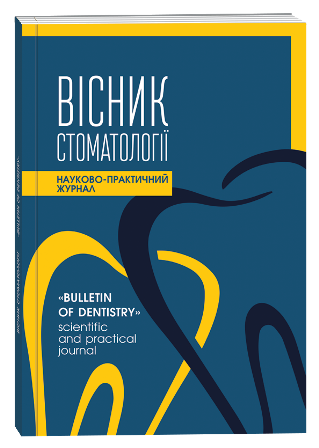JUSTIFICATION AND COMPARATIVE ANALYSIS OF THE USE OF A NEW DOMESTIC BIOACTIVE GLASS-CERAMIC MATERIAL FOR COATING THE SURFACE OF DENTAL IMPLANTS
DOI:
https://doi.org/10.35220/2078-8916-2024-54-4.22Keywords:
tooth extraction, implantation, osseointegration, bioactive glass-ceramic coating, immediate loadingAbstract
Studies have shown that immediate implantation has various advantages, such as short treatment time and psychological benefits for the patient. But today it still has quite a lot of complications and complaints after surgery, compared to the delayed method. Therefore, the aim of the study was to improve the quality of comprehensive treatment of dental patients with indications for tooth extraction by accelerating the process of osseointegration and stabilization of implants with immediate implantation compared to the classic delayed one by using the developed method of coating the implant surface with a new domestic bioactive calcium phosphate silicate glass ceramic. Materials and methods of the study – 39 patients with indications for the extraction of 47 teeth in the lateral department, aged 19 to 59 years, including 15 men and 24 women, were involved. All of them were divided into 2 groups ‒ I (main ‒ 13 women, 7 men), patients in which immediate implantation was performed immediately after extraction, and the surface of the implants was covered with bioactive calcium phosphate silicate glass ceramics; patients in the II (control – 10 women, 9 men) group underwent delayed implantation according to the standard protocol for the use of conventional implants. Scientific novelty. The study showed that in patients of the main group with implantation in the upper jaw and immediate loading, the indicator was (69.4±2.7) IST, while in the control group it was 36.6% lower and equal to (50.8±2.5) IST. A similar situation developed with implants placed on the lower jaw – (71.2±2.8) IST and (51.3±3.3) IST, respectively, for the main and control groups (p˂0.05), i.e. 38.8% difference. Regarding delayed loading, the indicators of the main group are also significantly (p˂0.01) better – 1 month after implantation, the average values for the upper and lower jaws are (70.9±2.3) IST and (72.6±2.4) IST, respectively, which is 21.3 % more, compared to the control group. Thus, the results of the study of the use of a new domestic bioactive glass-ceramic material for coating the surface of implants during implantation immediately after tooth extraction showed that a significant difference between the main and control groups with immediate loading at the level of p˂0.001, and with delayed loading at the level of p˂0.01 was established already at stage 1, that is, 1 month after implantation. Conclusions. Therefore, when using the proposed method, one can without hesitation perform immediate loading on either the upper or lower jaw, since the degree of osseointegration in both cases after 1 month is greater than 65 IST, which cannot be said about the results of the control group patients. In addition, the absence of a statistical difference in the IST index between the results with immediate and delayed loading at all stages was experimentally proven, while when using the standard implantation method this difference was statistically significant (p˂0.05) at the first stage.
References
Xu R., Hu X., Yu X., Wan S., Wu F., et al. Micro-/ nano-topography of selective laser melting titanium enhances adhesion and proliferation and regulates adhesion-related gene expressions of human gingival fibroblasts and human gingival epithelial cells. Int J Nanomedicine. 2018. №13. P. 5045-57. DOI: 10.2147/ IJN.S166661.
Savvova O.V., Bragina L.L., Shadrina G.N. et al. Surface properties of biocompatible calcium-silicon-phosphate glass ceramic materials and coat 3. Yanishen І.V., Fedotova O.L., Savielieva N.M., Khlystun N.L., Pogorila A.V. et al. Study of the influence of biocompatible construction materials on indicators of oral fluid of patients with an allergic status during orthopedic treatment with removable prostheses. World of Medicine and Biology. 2022. №. 4 (82). P. 201–205.
Yanishen I.V., Fedotova O.L., Andrienko K.Yu., Khlystun N.L., Hermanchuk S.M. Analysis of survival of orthopedic methods for restorations of total hard tissue defects of teeth in the manufacture of fixed dental constructions. World of Medicine and Biology. 2024. №. 2 (88). P. 190–193.
Ayers R.A., Wolford L.M., Balteman T.A. et al. Quantification of bone ingrowth into porous block hydroxyapatite in humans. J. Biomed. Mater. Res. 1999. Vol. 47. № 1. Р. 54-59.
Голеус В.І., Кислична Р.І., Нагорна Т.І. Склоемалеві покриття для крупногабаритних сталевих виробів. Вісник НТУ «ХПІ». Серія: Хімія, хімічна технологія та екологія. 2016. № 22 (1194). С. 58-62.
Загородько О.В., Антонюк Н.Г., Бурбан А.Ф. Загальна характеристика основних остеозаміщувальних імплантатів для кісткової пластики. Магістеріум: Хімічні науки. 2008. № 33. С. 29-35.
Hench L.L. The Future of Bioactive Ceramics. J. Mater. Sci. Mater. Med. 2015. Vol. 26. № 2. P. 86-90.
Turkyilmaz Ilser. Implant dentistry – a rapidly evolving practice. London: INTECH. 2011. №2. С. 83-108.
Bassir S.H., El Kholy K., Chen C.Y., Lee K.H., Intini G. Outcome of early dental implant placement versus other dental implant placement protocols: A systematic review and meta-analysis. J Periodontol. 2019. Vol. 90(5). P. 493-506. doi: 10.1002/JPER.18-0338
https://all-dent.com.ua/product/anycheck-neobiotech
Огнєв В.А. Біологічна статистика. Харків : ХНМУ, 2023. 316 с.









